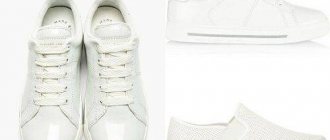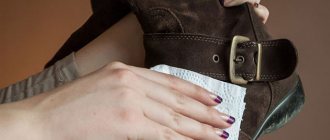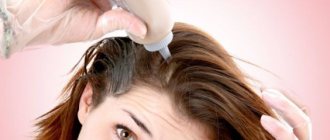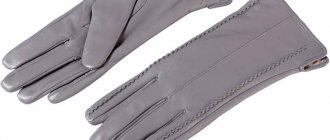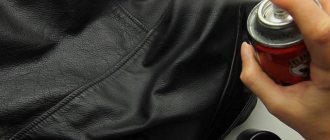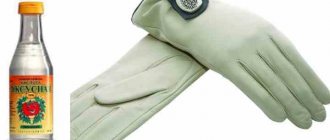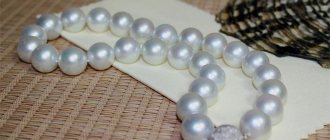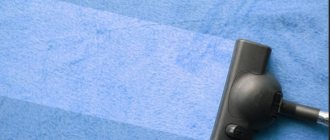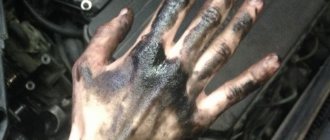Advantages and disadvantages
Artificial leather has its advantages:
- Availability. The low price is considered the main advantage, because of which many choose such products. Genuine leather costs significantly more.
- Durability and reliability. Modern processing methods are used to make the shoes durable. Therefore, it can last for several seasons.
- Comfort. The material is elastic, so your feet will be comfortable.
The disadvantages include the difficulty of care. Moreover, if this is done incorrectly, the material will deteriorate. The downside is that it is easily flammable.
Proper care
How to care for faux leather shoes? Care does not involve the purchase of many expensive products, from which many expect excellent results. Before using any purchased or prepared composition, you need to familiarize yourself with the type of leatherette.
Sometimes a substitute is made not only for smooth leather, for this reason it is necessary to take into account the technique for caring for velor shoes. It can also be suede or nubuck. Caring for faux leather shoes involves using the following products:
- Cream. It must match the color and have moisturizing properties, since the material is prone to drying out.
- Dye to remove scuffs and some damage.
- Moisture-repellent creams with natural waxes and paraffins. But these shoe products dry out quickly, which manifests itself in cracking of the surface of the composition. You should not use such creams.
- Liquid emulsions that are applied to lightweight products.
- Gloss creams that come with a sponge.
- Spray deodorant to remove odors.
- Cleaners in the form of a film or gel that remove heavy dirt.
- A brush or sponge used for dry cleaning.
- Flannel napkin.
Proper care of leatherette shoes
Properly caring for artificial leather does not mean purchasing a full arsenal of expensive products and then expecting that their mere presence can perpetuate inexpensive shoes.
Before using any of the drugs purchased or prepared at home, you need to study the nature of the leatherette and correctly identify it by type of manufacture and external data.
In addition, the substitute imitates not only smooth leather and you may need to pay attention to methods for caring for shoes made of velor (artificial, of course), suede or nubuck.
Below are the products that are considered included in the basic kit for the proper care of shoes made from analog materials of smooth leather:
- A cream that matches the color of the shoe and has a moisturizing effect, since artificial leather is prone to drying out;
- Dye for masking abrasions, microdamages or color fading;
- Protective moisture-repellent creams containing natural waxes and paraffins. Attention! - such shoe creams dry out quickly, which is externally expressed in cracking of the surface of the substance, loss of uniformity of the substance. Such damaged products must not be used;
- Liquid emulsions in bottles, applied primarily to lightweight items intended to be worn in warm weather;
- Gloss creams, as a rule, come complete with a special sponge, or in the form of a sponge soaked in a solution, packaged in a plastic case;
- Spray deodorant to eliminate odors is a necessary attribute for any closed shoes made of leatherette, as well as winter boots or boots;
- A cleaner in the form of a foam or gel substance that helps cope with severe stains;
- Brush and separate sponge for dry cleaning;
- A flannel napkin or cloth for wiping the leatherette surface dry.
We’ll talk further about the rules for the appropriate care of different types of leather, but now we’ll list the prohibitions that apply to all types of analog leather substitutes:
- Shoes made of leatherette or other types of synthetic material cannot be machine washed, dry-cleaned, or attempted to remove dirt by completely immersing them in water;
- It is prohibited to use regular gasoline, acetone-containing solutions, and alcohols;
- Exposure to hot air and direct sunlight is detrimental to imitation leather.
The best option to wash a product made of smooth artificial leather is to add 10 mg of simple shampoo to 0.5 liters of warm water, soak a piece of soft cloth in the foamy solution, wring it out and thoroughly wipe the contaminated areas. Be sure to first clean your shoes from dirt using a dry foam sponge or a brush with natural bristles.
Nubuck
Artificial nubuck is equally divided into advantages and disadvantages relative to real leather products. Thus, shoes made from a synthetic substitute are less breathable, more susceptible to wear and tear, but such a product also tolerates moisture more easily, is less clogged with dust and does not fade as much in the sun.
For proper dry care of eco-nubuck, soft suede brushes and the most ordinary car vacuum cleaner are used, which will carefully remove dust and remaining dry dirt from the pile. For wet cleaning, use highly purified gasoline or soapy water to wipe the soles. It is allowed to use ammonia diluted with water (1:3) if salt stains cannot be cleaned in the usual way.
Suede and velor
These materials, made on the basis of ordinary cotton, serve, as a rule, no more than two seasons, but if such shoes are worn only in exceptional cases and each time you carefully approach the care of the fragile pile surface and the subsequent storage of the pair, the life of the product can be extended up to several years.
Artificial suede tolerates wet washing well, but after each procedure, the boots must be completely dried at room temperature, stuffed with wrapping paper.
In winter, synthetic velor or suede will retain their appearance, provided that the temperature does not drop below −200C. It is best if shoes prepared for such extreme wear are treated in advance with nanospray, which increases the stress resistance of polyester products.
Rules
How to care for faux leather shoes at home so that they remain neat for a long time? It is necessary to remember the prohibitions that apply to all leather substitutes:
- Shoes made of leatherette and other synthetic materials are prohibited from being machine washed, dry-cleaned, or washed off dirt by absolute immersion in water.
- Do not use regular gasoline, acetone-containing solutions, or alcohol.
- Hot air and direct sunlight have a negative effect.
How to care for shoes made of artificial patent leather? To wash the product, you need to prepare a solution of warm water (0.5 l) and shampoo (10 mg). You need to soak a cloth in the solution, wring it out and treat the dirty areas. Be sure to clean the product from dirt in advance using a dry foam sponge or a brush with natural bristles.
Method 3. Hydrogen peroxide
To clean products made of white leatherette (for example, a sofa), use hydrogen peroxide. It perfectly removes even stubborn and old stains at home:
- Soak a cotton pad with hydrogen peroxide.
- Apply to the stain and leave for 30-40 seconds.
- Treat the stain.
- If this is not enough, re-moisten the cotton pad with peroxide and apply it to the product.
- Wipe the surface with a damp sponge.
- Wipe the product dry.
For maximum effect, use hydrogen peroxide and ammonia at the same time.
Nubuck
How to care for faux leather shoes if they are nubuck? Such products are less breathable and abrasion appears more quickly than real leather. But nubuck tolerates moisture more easily, accumulates less dust and does not fade much in the sun.
Proper care is performed using soft suede brushes. You can use a regular car vacuum cleaner, which carefully removes dust and dry dirt. For wet cleaning, you need soapy water to wipe the soles with. You can use ammonia diluted with water (1:3) if salt stains cannot be removed in the usual way.
Suede and velor
How to care for faux leather shoes if they are suede and velor? These materials, created on the basis of cotton, are used for no more than 2 seasons, but if such shoes are worn only on rare occasions and are provided with high-quality care, then the period of operation can be significantly extended.
For artificial suede, wet washing is allowed, but after the procedure the product must be dried at room temperature, stuffed with wrapping paper. In winter, velor or suede retain their appearance, provided that the temperature is not lower than -20 degrees. If shoes will be used under such extreme conditions, it is better to pre-treat them with nanospray, which improves the stability of the products.
Using Cleaning Products
It is important to keep in mind that although leatherette is more resistant to chemicals, it is not recommended to use harsh chemicals and detergents containing kerosene, ammonia, alcohol and solvents that contain acetates, cyclohexanone or tetrahydrofuran.
The important issue is consistency. Don't neglect regular maintenance. Any dirt must be removed immediately after it appears. Remember that water-based agents are recommended. What is most important:
- regularity;
- soft sponges/cloths;
- judicious use of chemicals;
- water-based cleaning products.
Good to know:
- First of all, it is necessary to have specialized products for the care of artificial leather. This material is quite different in structure from natural leather and therefore requires appropriate care.
- Regular cleaning is required .
- Like any material, artificial leather also has its own outer shell, which must be protected. For this purpose, special impregnation . To dye shoes, use products intended only for this purpose.
These principles will allow you to keep your shoes in good condition for a long time, and not just for one season.
New shoes
When buying shoes, you should choose a model based on your foot size and individual characteristics, since stretching such leather is a difficult task. Imitation materials are not as flexible and quickly become unusable if worn for a long time. Products with laces should not be tightened tightly - the punched holes are torn, and the shoes quickly lose their neat appearance.
After purchase, it is advisable to treat the shoes with cream and wax or paraffin. How to care for faux leather shoes if you just bought them? This must be done according to the following rules:
- From a wet product, you can only remove the dirt that has stuck to the sole.
- Cleaning, removing stains, and restoring color must be done when the material is dry.
- Drying should be done far from heat dissipators. If you need to dry your boots in a short time, you should use a hairdryer set to minimum heat. Drying in this way should be no closer than 30 cm.
Products placed in a box should be periodically checked to see if the skin is dry. For prevention, it is necessary to treat with a dry brush to remove dust and treat with a nourishing cream.
Effective means
How to care for faux leather shoes in spring? Care at this time consists of periodic wet and dry cleaning. You also need to use the rules for removing various stains:
- Traces of chocolate and caramel can be removed using a paste made from grated glycerin soap and water.
- Resin and melted rubber are removed more easily if a cloth soaked in turpentine oil is applied to the stain for 10 minutes, and then the damaged area is wiped.
- Stains from sugary or dairy drinks can be removed with soapy water.
- The melamine sponge allows you to get rid of traces from a ballpoint pen or felt-tip pen.
- Oily greasy stains are removed using pure turpentine.
- Traces of grass can be removed with lemon juice.
You can try removing fresh stains of any kind with dishwashing detergent diluted in water. Then the remaining chemicals must be thoroughly wiped off with a damp cloth.
How to care for faux leather shoes in summer
Summer care for beautiful lightweight shoes made from leather substitutes consists of daily cleaning them from dust and periodically restoring the material that is damaged during wear. Since the coloring pigment added to leatherette products is not very durable, from time to time you need to use dyes that are suitable for the type of leather of the shoes and match the original color as closely as possible.
Folk remedies
Summer is not only a period of heat, it is also an opportunity to reward beautiful sandals with a whole palette of diverse stains from food or household pollutants, which you will then have to get rid of:
- Traces of organic origin - blood, animal saliva, cat or dog urine, etc.: mix 1 tbsp. spoon liquid laundry detergent and ammonia, add 200 ml of cool water. Spread the mixture over the stained area with a sponge and after 10 minutes rub the treated area with a damp cloth;
- Stains from ice cream or sweet syrups can be easily removed with simple razor foam: shake the bottle, apply the substance to the stain, and use the corner of a cloth to rub the foam into the damaged area. After 5 minutes, you can wash off the remaining product.
Reddish stains on light-colored shoes that appear as a result of improper storage can be removed using a neutral spray for cleaning mirrors and glass.
Professional products
Shoes that are too bright, for which it is difficult to choose the appropriate cream, are best treated with a sponge soaked in a colorless compound that does not require any additional action. A good example of such an express product is Kiwi “Express Shine” - a sponge that you can take with you.
A new direction in shoe cosmetics is liquid leather, which restores severely damaged surfaces, returning the product to the appearance of new. The most famous product of this line, Creme RENOVATRICE from Saphir, is applied once every 2-3 weeks in one or two layers, while outwardly creating a complete feeling of the smooth surface of recently purchased shoes, even if the shoes have been worn for more than one season.
It is possible to prefer artificial leather not for reasons of economy, but, for example, for reasons of humanity, so they produced shoe products that produced brand-name cosmetics and took the issue of caring for leatherette seriously. Often, samples of creams designed to protect non-natural materials are far ahead in a technological sense of conservative products made according to traditional formulas.
Professional Products
If shoes have just been purchased, they do not require creams with a coloring or restorative effect. It is advisable not to skimp on high-quality preventative and care products:
- Creme de luxe, Saphir. This is a tube with a sponge that will help regulate the intensity of the substance supply. The cream contains resins with fluoride and natural wax. These components retain the necessary moisture, protect against cracking, and add shine.
- Salton "Shine Express". Products in the form of a cream are intended for smooth skin that does not need polishing. The product softens rough areas and smoothes out microcracks. It also serves as protection against wrinkles in the skin of the boot or in the toe area, where folds often appear. Regular use of the cream ensures long-term preservation of the skin.
All creams and emulsions should be applied only to a clean and dust-free shoe surface, otherwise the care will not bring any results. If this rule is followed, it will have a neat appearance and long-term operation will be ensured.
General care recommendations
Shoes with leatherette uppers age much faster and lose their elastic and aesthetic properties. Pastes and creams intended for this purpose should be used as preservatives. Pastes must be water-based , prepared without solvents or waxes. It is unacceptable to wash leatherette shoes in a washing machine.
The main thing is to clean the dirt on a regular basis, because if it is not removed, it can lead to discoloration of the material. Very simple and cheap maintenance - just soap and water. Apply a small amount of liquid and wipe gently with a sponge. After rinsing, wipe with a dry cloth or paper towel. For cleaning, do not use hard brushes , hard sponges or rough cloth. Give preference to soft materials.
How to clean white soles of shoes
in winter
If products are often exposed to stress, for example, difficult weather conditions, then they quickly lose their external luster and look sloppy. Therefore, it is advisable for residents of central Russia to have at least 2 pairs of shoes - for frost and slush. In the second case, there should be rubberized insulated boots, and for the first, leatherette products are suitable. In winter, salt stains, dirt with road reagents, and microdamages from severe frosts may appear on the surface.
How to care for faux leather shoes in winter? Dirt can be removed dry or with a brush or dry cloth. After removing the bulk of the dirt, you can remove traces of it. You can use a solution of glycerin soap or shampoo. Use a napkin or sponge to eliminate the consequences of being outside.
After the cleaning procedure, the products should be dried and treated with cream. And at night you should use an odor remover.
How to care for faux leather shoes in winter
If artificial leather is often exposed to stress caused by difficult weather conditions, it quickly loses its outer luster and looks sloppy. Therefore, for such a difficult period as winter in central Russia, you need to have at least two pairs of shoes - for frosty weather and slush. In the second case, rubberized, insulated boots are suitable, and for the first, you can purchase fashionable leatherette shoes. What difficulties do owners of economy shoes face in winter? With salt stains, with traces of liquid mud mixed with road reagents, with microdamages that form on leatherette during severe frosts and, which is also unpleasant, with an unpleasant odor that haunts owners of boots made of artificial material throughout the cold period.
Dirt can only be removed from shoes when it has dried and only with a brush or dry cloth. When the bulk of the contaminants have been removed, they begin to eliminate traces of them.
Depending on the type of residual stain, a solution is prepared - most often using glycerin soap or ordinary shampoo and with this mixture, using a napkin or sponge, the consequences of being outdoors are washed away.
It is important not to forget to completely dry and cream your shoes after water procedures, and at night you can also use one of the means to eliminate unpleasant odors - this indispensable companion to warm winter shoes made of impenetrable synthetic fiber.
Folk remedies
Quite a few antiseptic or bad odor-eliminating means at hand have been taken from the people's treasury; All that remains is to find among them the one that suits each specific case:
- A paste that completely absorbs the persistent odor of sweat: take 5 teaspoons of baking soda. 2 teaspoons of any starch and 6 drops of peppermint, tea tree or lemongrass oil (optional). Rub the inside of the shoes with the ground mixture and leave for 6-8 hours, after which the powder is simply shaken out;
- Pour as many fresh orange or lemon peels (from 3-4 fruits) into a dry boot and leave overnight;
- Wipe the entire inner surface of the frame with a napkin soaked in vinegar, then pack the shoes individually in plastic bags and put them away for 4-6 hours.
To prevent the formation of odors, it is useful to wipe the inside of winter shoes every 4-5 days with a cotton wool soaked in 3% peroxide.
Professional products
Winter care products must combine water-repellent and nutritional properties and must have a restorative effect:
- Nanomax, Leather Cleaner is a cream-softener that simultaneously nourishes overdried artificial leather and cleanses it of traces of dirt. Does not allow the formation of cracks and creases, does not require additional polishing, is completely absorbed in 15 minutes;
- Salton Professional is a semi-liquid cream sold in a tube, containing a special oil formula of the latest developments in Comlex Oil shoe cosmetics, which repels liquid dirt, preventing it from being absorbed into the skin and at the same time cares for the surface of the shoe using silicone gel and mink oil.
After applying the care product, any winter shoes should be kept at room temperature for several hours.
Wet wipes
But these are not classic wet wipes, but special ones. They are used for products of different colors. AV PROLANG and Casablanca wipes are designed for artificial leather. They clean the surface perfectly and can be used daily.
The wipes perfectly clean, refresh, and maintain a beautiful appearance. The products do not contain substances harmful to the material. They are sold in small packs of 15 and 20 pieces. Excess moisture is harmful to artificial material, so this cleaning method is more suitable than washing.
Turpentine
If oily paint gets on leatherette, how to clean shoes? Curious housewives have tried many home remedies to get rid of this stain. And the best thing was the use of turpentine.
It effectively removes this kind of pollution and does not spoil the artificial material.
The stain should be removed with purified turpentine. Apply a small amount to a cloth, bring it to the stain and rub thoroughly. Rub until the stain completely disappears; you can add purified turpentine to the sponge as needed.
After removing the stain, wash your shoes with soapy water and dry immediately.
Lemon juice
If your shoes have traces of green grass or greasy food stains, then cleaning is necessary. Citric acid or the juice of 1 citrus fruit is suitable for this. This product is safe.
You need to squeeze the juice into a separate bowl. You should take a cotton swab, soak it in the solution and treat the stain. After 5-20 minutes, you need to wash the product with water. Lemon juice is only suitable for fair skin, otherwise the dark version will be ruined.
Thus, shoe care is not as difficult as it might seem at first glance. If it is done in a timely manner, it will allow you to wear it for several seasons.
Method 2. Ammonia and dishwashing gel
More difficult stains (for example, from greasy foods) can be removed using ammonia compounds and dishwashing detergent. This is one of the most effective ways to cleanse:
- Mix ammonia (1 tbsp) and dish soap (1/2 tsp) in cold water (1 tbsp).
- Apply the solution to the stain using a rag or sponge.
- Treat the stain.
- Remove any remaining solution.
- Wipe the product with a dry cloth (sponge).
Life hack from experts: for greater effect, treat the dirt not with a sponge, but with a toothbrush. If necessary, the procedure can be repeated. You can replace the dishwashing detergent with another household gel (for example, for washing laminate floors).
